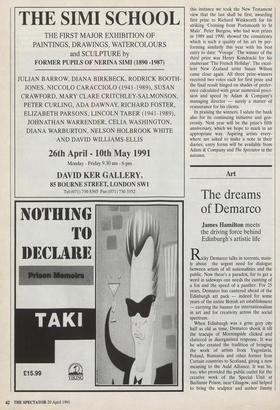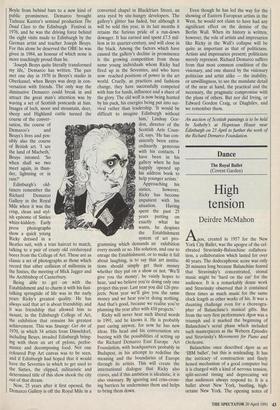Art
The dreams of Demarco
James Hamilton meets the driving force behind Edinburgh's artistic life
Ricky Demarco talks in torrents, main- ly about the urgent need for dialogue between artists of all nationalities and the public. Now there's a paradox, for to get a word in sideways one needs the cunning of a fox and the speed of a panther. For 25 years, Demarco has cantered ahead of the Edinburgh art pack — indeed for some years of the entire British art establishment — carrying the banner for internationalism in art and for creativity across the social spectrum.
When Edinburgh was a grim grey city half as old as time, Demarco shook it till the teacups of Morningside clicked and clattered in disorganised response. It was he who created the tradition of bringing the work of artists from Yugoslavia, Poland, Rumania and other former Iron Curtain countries to Scotland, giving a new meaning to the Auld Alliance. It was he, too, who provided the public outlet for the creative work of the Special Unit at Barlinnie Prison, near Glasgow, and helped to bring the sculptor and author Jimmy Boyle from behind bars to a new kind of public prominence. Demarco brought Tadeusz Kantor's seminal production The Dead Class to the Edinburgh Festival in 1976, and he was the driving force behind the eight visits made to Edinburgh by the German artist and teacher Joseph Beuys. For this alone he deserved the OBE he was given in 1984, an honour of which none is more touchingly proud than he.
`Joseph Beuys quite literally transformed my life,' Demarco has written. The pair met one day in 1970 in Beuys's studio in Oberkassel, when Beuys was deep in con- versation with friends. The only way the diminutive Demarco could break in and attract the great man's attention was by waving a set of Scottish postcards at him. Images of loch, moor and mountain, deer, sheep and Highland cattle turned the course of the conver- sation, the course of Demarco's and Beuys's lives and pos- sibly also the course of British art. 'I see the land of Macbeth,' Beuys intoned. 'So when shall we two meet again, in thun- der, lightning or in rain?'
Being able to get on with the Establishment and to charm it with his fast- talking springtide of life was in the early years Ricky's greatest quality. He has always said that art is about friendship, and it was friendship that allowed him to mount, in the Edinburgh College of Art, the exhibition that remains his greatest achievement. This was Strategy: Get Art of 1970, in which 34 artists from Dilsseldorf, including Beuys, invaded Edinburgh bring- ing with them an art of pylons, perfor- mance and decomposing food. Not one coloured Pop Art canvas was to be seen, and if Edinburgh had hoped that it would have the Seventies in which to get used to the Sixties, the clipped, militaristic and determined title of this show shook the city out of that dream.
Now, 25 years after it first opened, the Demarco Gallery is off the Royal Mile in a converted chapel in Blackfriars Street, an area eyed by site-hungry developers. The gallery's glitter has faded, but although it will be sold this year, in its last months it retains the furious pride of a run-down dowager. It has earned and spent £7.5 mil- lion in its quarter-century, and will close in the black. Among the factors which have caused the gallery's decline in prominence is the growing competition from those same young individuals whom Ricky had fired up in the Seventies, and who have now reached positions of power in the art world. Cruelly, as practices and fashions change, they have successfully competed with him for funds, influence and a share of the glory. The old wolf is now being hunted by his pack, his energies being put into sur- vival rather than leadership. 'It would be difficult to imagine Edinburgh without him,' Lindsay Gor- don, director of the Scottish Arts Coun- cil, says. 'He has con- sistently been extra- ordinarily generous with his contacts. I have been in his gallery when he has happily opened up his address book to help younger artists.'
Approaching his sixties, however, Ricky has become impatient with his situation. Having spent the past 25 years putting on exactly what he wants, he despises the Establishment system of art pro- gramming which demands an exhibition every month or so. His solution, and one to enrage the Establishment, or to make it fall about laughing, is to say that art institu- tions should simply get their money whether they put on a show or not. 'We'll give you the money', he vainly hopes to hear, 'and we believe you're doing only one project this year. Last year you did 126 pro- jects. Next year we'll give you the same money and we hear you're doing nothing. And that's good, because we realise you're planning the year after with 450 projects.' Ricky will never hear such liberal words in 1991, and he knows it. He is probably past caring anyway, for now he has new ideas. His head and his conversation are buzzing with the possibilities of setting up the Richard Demarco East Europe Art Foundation, with headquarters probably in Budapest, in his attempt to redefine the meaning and the boundaries of Europe through its artists. This will create the international dialogue that Ricky also craves, and if this ambition is idealistic, it is also visionary. By ignoring and criss-cross- ing barriers he undermines them and helps to bring them down. Even though he has led the way for the showing of Eastern European artists in the West, he would not claim to have had any significant effect on the demise of the Berlin Wall. When its history is written, however, the role of artists and impresarios like Ricky in the Wall's collapse will be quite as important as that of politicians. Artists and impresarios present; politicians merely represent. Richard Demarco suffers from that most common condition of the visionary, and one shared by the visionary politician and artist alike — the inability, or unwillingness, to see the mundane detail of the near at hand, the practical and the necessary, the pragmatic compromise with the plans of others. But nor did Irving, or Edward Gordon Craig, or Diaghilev, and we remember them.
An auction of Scottish paintings is to be held by Sotheby's at Hopetoun House near Edinburgh on 23 April to further the work of the Richard Demarco Foundation.



























































 Previous page
Previous page